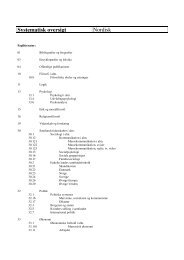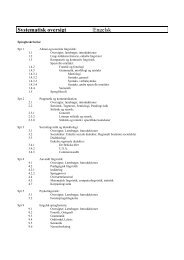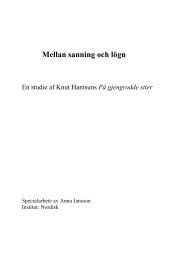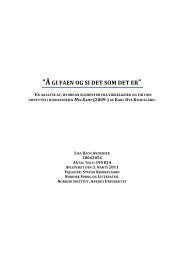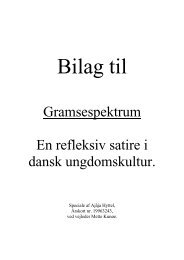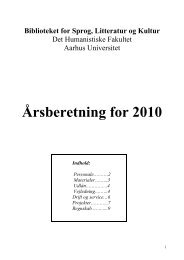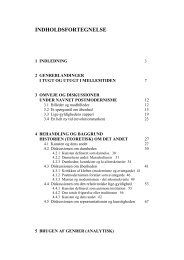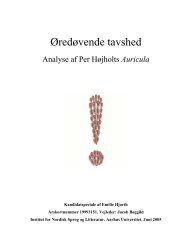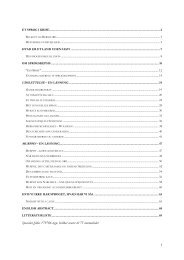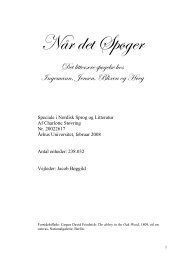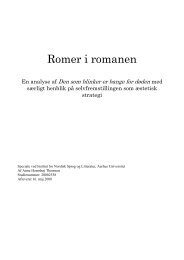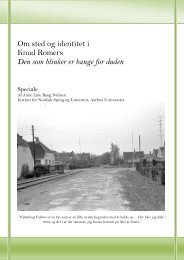RØDE MORD INDLEDNING 4 KRIMINALLITTERATURGENREN 6 ...
RØDE MORD INDLEDNING 4 KRIMINALLITTERATURGENREN 6 ...
RØDE MORD INDLEDNING 4 KRIMINALLITTERATURGENREN 6 ...
Create successful ePaper yourself
Turn your PDF publications into a flip-book with our unique Google optimized e-Paper software.
11. A servant must not be chosen by the author as the culprit. This is begging a noble question.<br />
It is a too easy solution. The culprit must be a decidedly worth-while person--one that<br />
wouldn't ordinarily come under suspicion.<br />
12. There must be but one culprit, no matter how many murders are committed. The culprit<br />
may, of course, have a minor helper or co-plotter; but the entire onus must rest on one pair<br />
of shoulders: the entire indignation of the reader must be permitted to concentrate on a single<br />
black nature.<br />
13. Secret societies, camorras, mafias, et al., have no place in a detective story. A fascinating<br />
and truly beautiful murder is irremediably spoiled by any such wholesale culpability. To be<br />
sure, the murderer in a detective novel should be given a sporting chance; but it is going<br />
too far to grant him a secret society to fall back on. No high-class, self-respecting murderer<br />
would want such odds.<br />
14. The method of murder, and the means of detecting it, must be rational and scientific. That<br />
is to say, pseudo-science and purely imaginative and speculative devices are not to be tolerated<br />
in the roman policier. Once an author soars into the realm of fantasy, in the Jules<br />
Verne manner, he is outside the bounds of detective fiction, cavorting in the uncharted<br />
reaches of adventure.<br />
15. The truth of the problem must at all times be apparent--provided the reader is shrewd<br />
enough to see it. By this I mean that if the reader, after learning the explanation for the<br />
crime, should reread the book, he would see that the solution had, in a sense, been staring<br />
him in the face-that all the clues really pointed to the culprit--and that, if he had been as<br />
clever as the detective, he could have solved the mystery himself without going on to the final<br />
chapter. That the clever reader does often thus solve the problem goes without saying.<br />
16. A detective novel should contain no long descriptive passages, no literary dallying with<br />
side-issues, no subtly worked-out character analyses, no "atmospheric" preoccupations.<br />
such matters have no vital place in a record of crime and deduction. They hold up the action<br />
and introduce issues irrelevant to the main purpose, which is to state a problem, analyze<br />
it, and bring it to a successful conclusion. To be sure, there must be a sufficient descriptiveness<br />
and character delineation to give the novel verisimilitude.<br />
17. A professional criminal must never be shouldered with the guilt of a crime in a detective<br />
story. Crimes by housebreakers and bandits are the province of the police departments-not<br />
of authors and brilliant amateur detectives. A really fascinating crime is one committed<br />
by a pillar of a church, or a spinster noted for her charities.<br />
18. A crime in a detective story must never turn out to be an accident or a suicide. To end an<br />
odyssey of sleuthing with such an anti-climax is to hoodwink the trusting and kind-hearted<br />
reader.<br />
19. The motives for all crimes in detective stories should be personal. International plottings<br />
and war politics belong in a different category of fiction--in secret-service tales, for instance.<br />
But a murder story must be kept gemütlich, so to speak. It must reflect the reader's everyday<br />
experiences, and give him a certain outlet for his own repressed desires and emotions.<br />
20. And (to give my Credo an even score of items) I herewith list a few of the devices which no<br />
self-respecting detective story writer will now avail himself of. They have been employed<br />
too often, and are familiar to all true lovers of literary crime. To use them is a confession of<br />
the author's ineptitude and lack of originality. (a) Determining the identity of the culprit by<br />
comparing the butt of a cigarette left at the scene of the crime with the brand smoked by a<br />
suspect. (b) The bogus spiritualistic séance to frighten the culprit into giving himself away.<br />
(c) Forged fingerprints. (d) The dummy-figure alibi. (e) The dog that does not bark and<br />
thereby reveals the fact that the intruder is familiar. (f)The final pinning of the crime on a<br />
twin, or a relative who looks exactly like the suspected, but innocent, person. (g) The hypodermic<br />
syringe and the knockout drops. (h) The commission of the murder in a locked room<br />
after the police have actually broken in. (i) The word association test for guilt. (j) The cipher,<br />
or code letter, which is eventually unravelled by the sleuth.<br />
99



